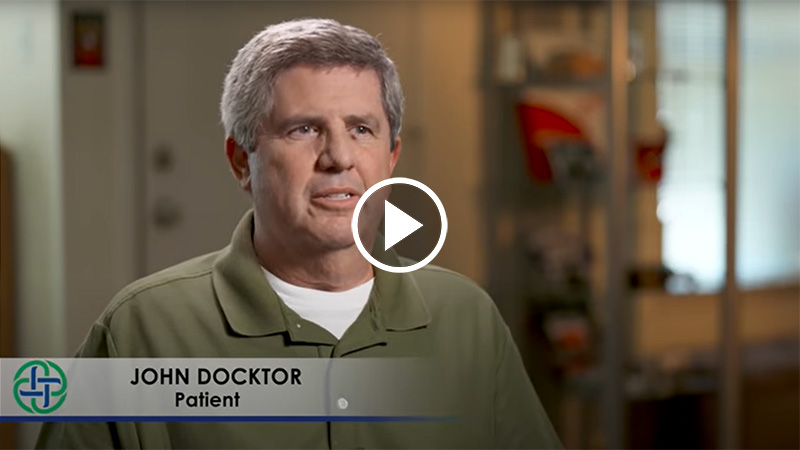When John Docktor isn’t at work, he can likely be found in his garage. He may not be a grease monkey by trade, but the 63-year-old husband and father is passionate about fixing cars. He’s been known to bring old models back to life and build hot rods from the ground up. It’s the problem-solving nature of putting things back together that John says is especially appealing. So, when the Bedford resident began losing his interest in tinkering, and life in general, those around him were puzzled.
Watch John's Story
“He’d come home from work, he’d sit in the chair, and he’d immediately go to sleep,” recalls John’s wife, Kendra Docktor. “He wasn’t interested in anything.”
The changes in John’s energy level and demeanor were subtle, initially causing friends and family to chalk them up to aging. It wasn’t until one day at work that things took a dramatic turn.
“I was talking, really in gibberish,” John says. “I was hearing myself just fine, but my coworkers were hearing all kinds of crazy talk.”

After some convincing, John was taken to Texas Health Harris Methodist Hospital Fort Worth, where the obvious severity of his condition warranted specialized attention from neurosurgeon Yinn Ooi, M.D., a physician on the hospital’s medical staff and at Texas Health Neurosurgery & Spine Specialists, a Texas Health Physicians Group practice. A CT scan of John’s brain revealed a very complex and dangerous dural arteriovenous fistula, a rare condition brought on by irregular connections between arteries and veins. In John’s case, the dural AVF was causing pressure to build up in his brain. Thus, why his speech was impaired and he had experienced issues with memory loss, headaches, and blurred vision.
“In simple terms, he had a very complex, abnormal network of blood vessels that allow blood to be shunted abnormally through the brain, leading to swelling, causing brain dysfunction and even bleeding in the brain,” Ooi explains.
If left untreated, or if treatment wasn’t done effectively, John’s condition could leave him blind, unable to speak, and with a life-threatening brain bleed. The grim news was a lot for John and the Docktor family to grasp. But with a diagnosis made, the problem-solving could begin. It just had to be quick.
“At the time of John’s diagnosis, we had another major event going on in our family,” Kendra notes. “And that was my son’s wedding, which was taking place in two weeks.”
An Advanced Treatment Plan for An Advanced Timeline
To expedite John’s treatment, Ooi came up with a detailed remedy that spanned two minimally invasive surgical procedures that could be done fairly quickly with little downtime. First, he had to map out the extent of the problem by getting a visual on the lesion. This required performing a diagnostic cerebral angiogram and partially taking care of the abnormal blood flow through the fistula.
Then he had to fully fix the lesion by performing an endovascular embolization. Slowly and meticulously the abnormal connections between the arteries and the veins were disconnected to completely shut down the fistula.
“We advanced a really fine catheter all the way into the brain to be able to plug up the abnormal vessels of the brain, hence addressing the shunting of the blood and the swelling of the brain,” Ooi says.
John woke up in the hospital and immediately felt better. Just three days following the second procedure, he was able to attend his son’s wedding.
“Dr. Ooi made it happen so that we could enjoy our son’s wedding together,” Kendra adds.
“Dr. Ooi is really amazing. I trust him completely… I’ve really gotten my life back because of this. It’s wonderful,” John says.
Learn more about advanced neurological care at Texas Health or find a neurosurgery specialist near you.


